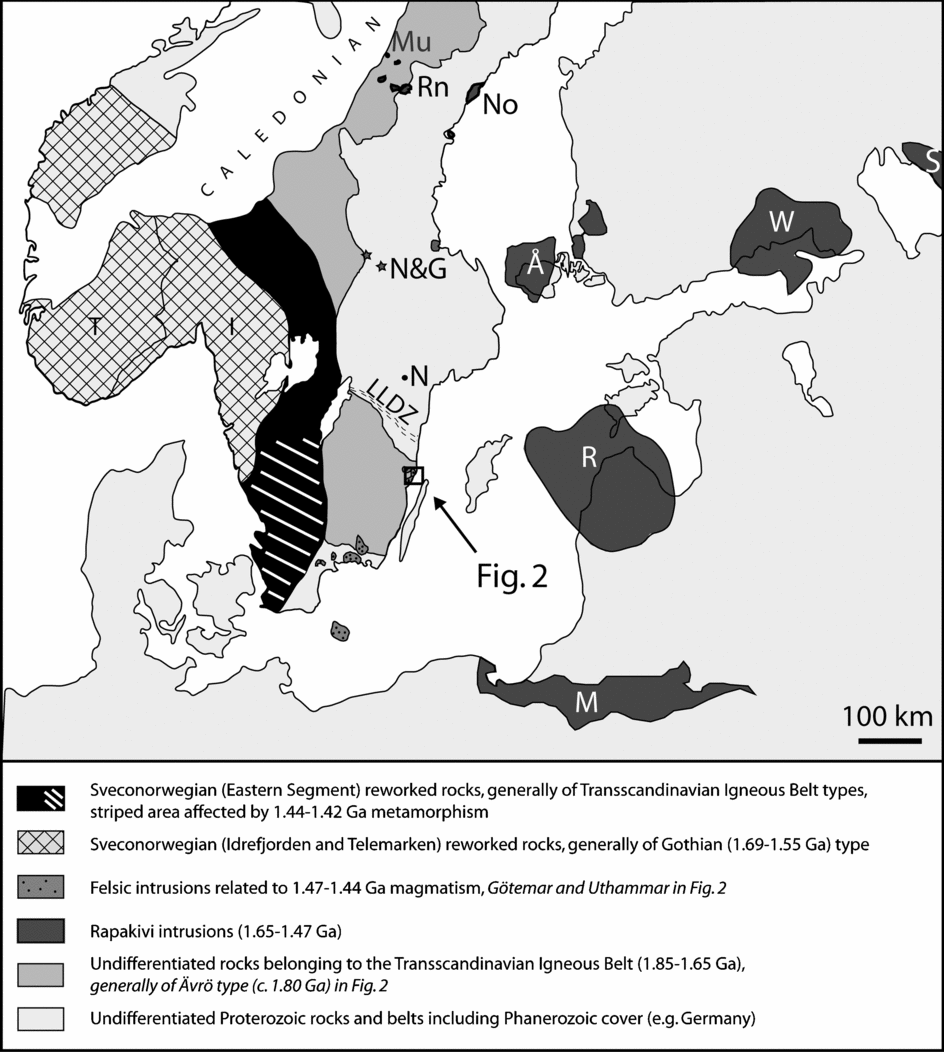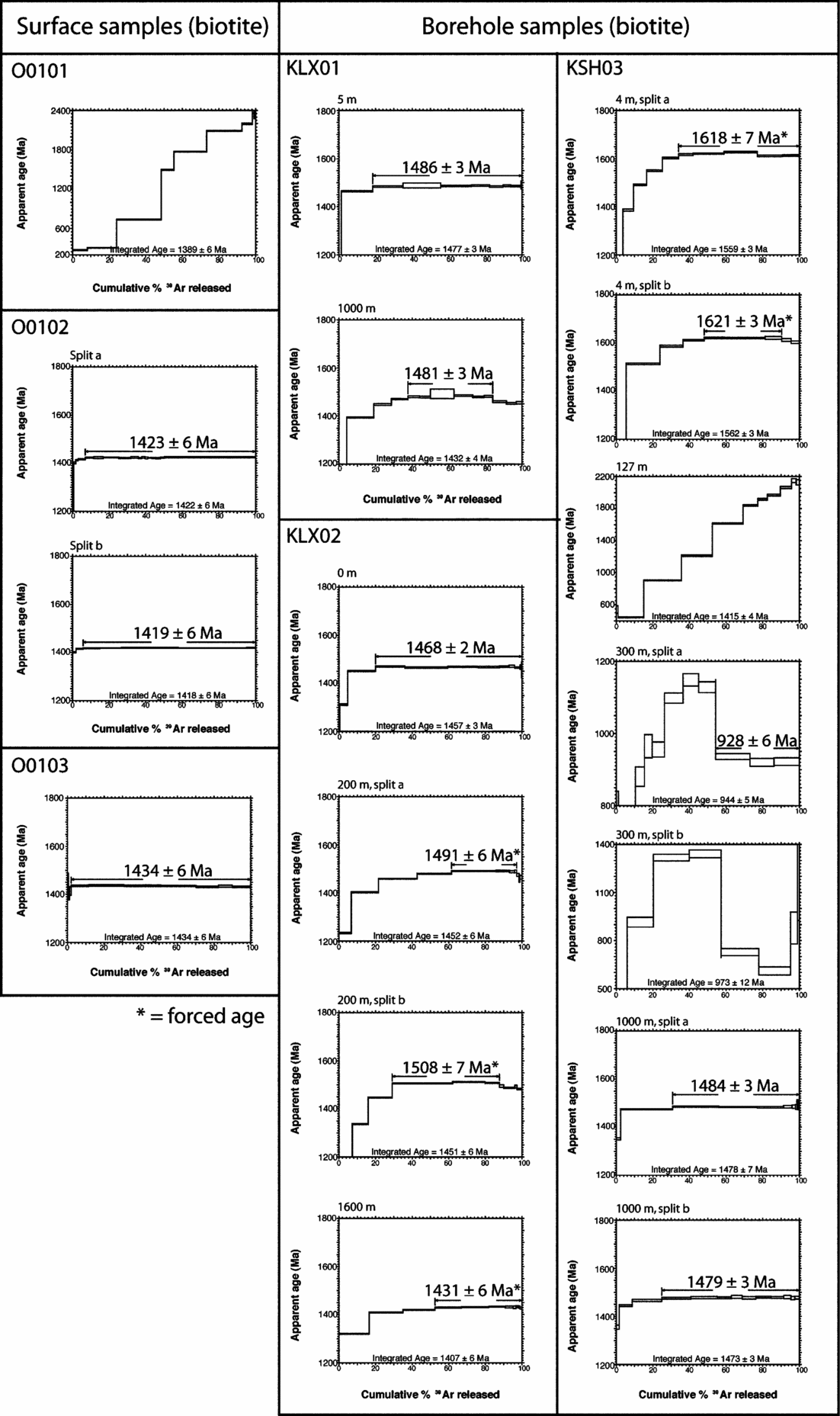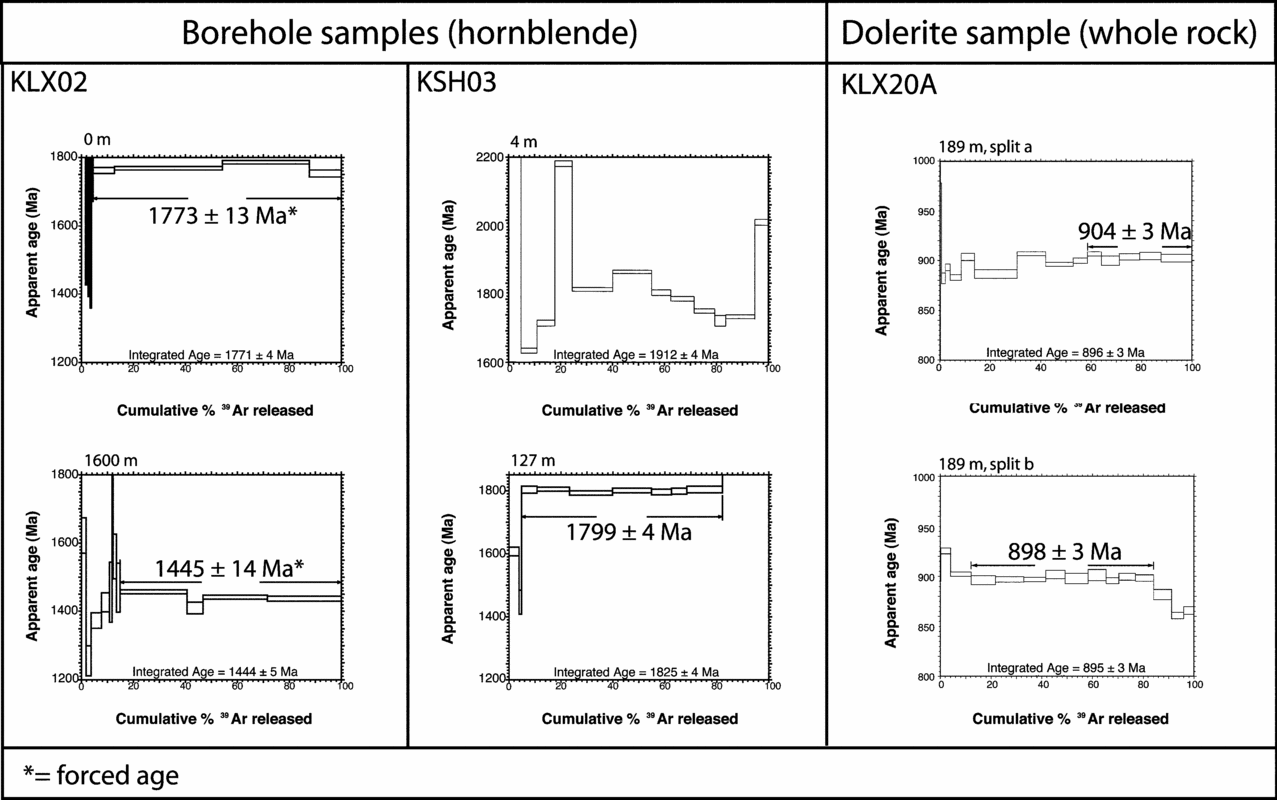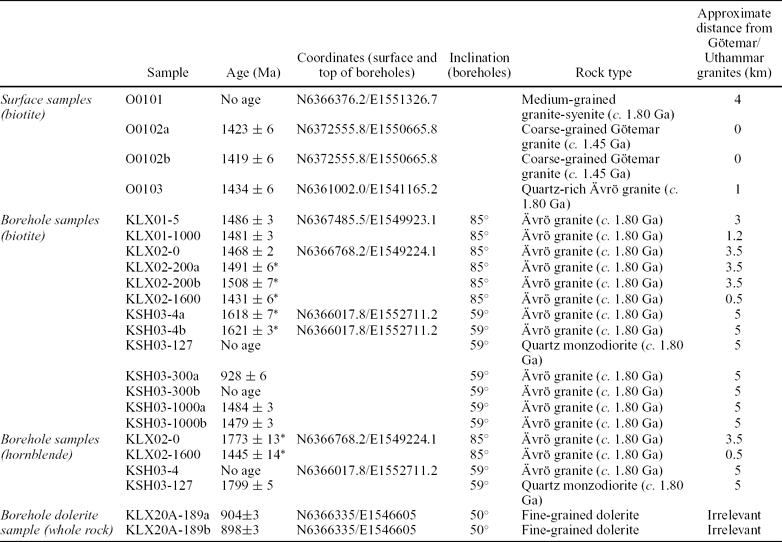1. Introduction
Sweden is part of the Fennoscandian Shield, which has an old and protracted history of crust-forming events associated with magmatism, tectonism, deformation and metamorphism. The oldest rocks of Archaean age occur in the northeast. Younger rocks have subsequently been accreted to the Archaean nucleus during different stages of orogenic and magmatic events throughout the Proterozoic era. Many of these events are reasonably well established by geographic and temporal definitions, such as the Svecofennian orogeny, the Transscandinavian Igneous Belt, the Gothian event and the Sveconorwegian orogeny. In intervening periods, different generations of mafic dyke swarms and felsic plutons were emplaced.
Scattered intracontinental rapakivi complexes intruded the Fennoscandian Shield (Fig. 1) between c. 1.65 and 1.47 Ga. In this study the term ‘rapakivi’ is used for the classic 1.65–1.47 Ga intrusive complexes such as the Wiborg and Åland complexes in Finland (Suominen, Reference Suominen1991; Alviola et al. Reference Alviola, Johanson, Rämö and Vaasjoki1999), the Salmi complex in Russia (Amelin, Larin & Tucker, Reference Amelin, Larin and Tucker1997), the Riga massif in Estonia (Rämö, Huhma & Kirs, Reference Rämö, Huhma and Kirs1996), the Mazury complex in Poland (Dörr et al. Reference Dörr, Zdzislaw, Marheine, Schastok, Valverde-Vaquero and Wiszniewska2002) and the smaller massifs in central Sweden, such as the Nordingrå (Welin & Lundqvist, Reference Welin and Lundqvist1984), Ragunda (Persson, Reference Persson1999), Mullnäset (Andersson, Neymark & Billström, Reference Andersson, Neymark and Billström2002) and Noran (Claesson & Kresten, Reference Claesson and Kresten1997) massifs. Our definition does not include younger AMCG-suits or A-type granites often mentioned in the same context with rapakivi magmatism (e.g. Bogdanova et al. Reference Bogdanova, Page, Skridlaite and Taran2001; Dörr et al. Reference Dörr, Zdzislaw, Marheine, Schastok, Valverde-Vaquero and Wiszniewska2002; Skridlaite, Wiszniewska & Duchesne, Reference Skridlaite, Wiszniewska and Duchesne2003). Åhäll, Connelly & Brewer (Reference Åhäll, Connelly and Brewer2000) suggested that the emplacement of rapakivi intrusions was linked to Gothian (c. 1.69–1.55 Ga) orogenic activity in the west.
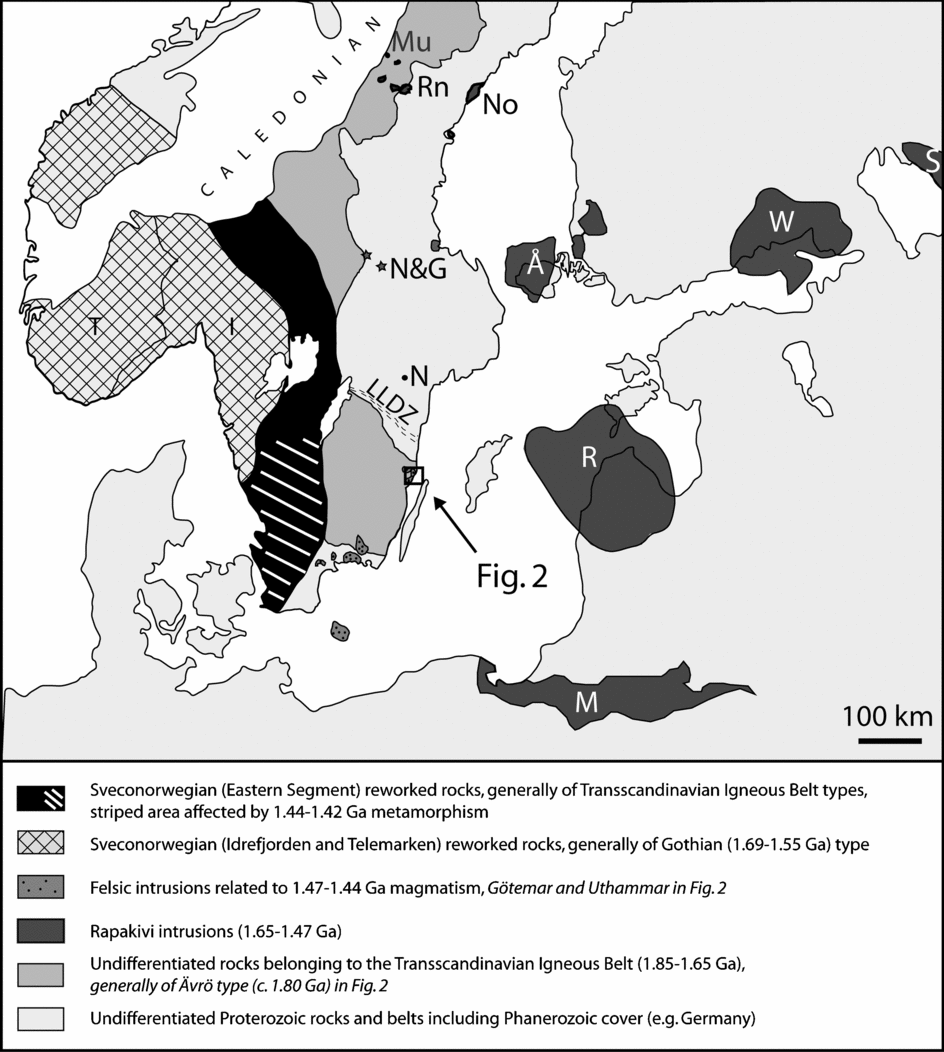
Figure 1. Simplified geological map of southern Fennoscandia (modified from Brander & Söderlund, Reference Brander and Söderlund2008). I – Idefjorden terrain; LLDZ – Loftahammar-Linköping Deformation Zone; M – Mazury complex; Mu – Mullnäset complex; N – Norrköping; No – Nordingrå complex; N&G – Noran and Gustaf massif; R – Riga complex; Rn – Ragunda complex; S – Salmi complex; T – Telemarken terrain; W – Wiborg complex; Å – Åland complex.
Younger Mesoproterozoic intrusions have been considered to represent plutonism associated with N–S compressive tectonism of the Danopolonian event (e.g. Čečys et al. Reference Čečys, Bogdanova, Janson, Bibikova and Kornfält2002; Čečys & Benn, Reference Čečys and Benn2007; Bogdanova et al. Reference Bogdanova, Bingen, Gorbatschev, Kheraskova, Kozlov, Puchkov and Volozh2008). Originally this event was proposed to include 1.54–1.45 Ga magmatism and compressional tectonism found in northern Poland, on Bornholm and in SW Sweden (Čečys et al. Reference Čečys, Bogdanova, Janson, Bibikova and Kornfält2002; Bogdanova et al. Reference Bogdanova, Bingen, Gorbatschev, Kheraskova, Kozlov, Puchkov and Volozh2008). Brander & Söderlund (Reference Brander and Söderlund2008) linked the 1.47–1.44 Ga mafic and felsic magmatism to an orogenic setting, and suggested that the age limits of the Danopolonian should be set by the 1.47–1.44 Ga intrusions, that is, not including the earlier, scattered events of rapakivi magmatism.
One of the strengths of 40Ar–39Ar geochronology lies in its potential to record low temperature effects of low-grade or distal tectonic processes, which may not be registered by traditional higher-temperature geochronometers. The bedrock in the Oskarshamn area, in particular the Simpevarp–Laxemar area (Fig. 2, left), has been studied in detail by the Swedish Nuclear Fuel and Waste Management Company (SKB), as it has been chosen as a possible site for underground long-term storage of nuclear waste. For the site-evaluation process it is important to understand the thermal history of rocks in the area. This study aims to investigate the thermal evolution in the 300–500°C interval of the upper crust in the Simpevarp–Laxemar area, Oskarshamn (Fig. 2, left), where the bedrock consists predominantly of 1.80 Ga igneous rocks and neighbouring 1.45–1.44 Ga granite plutons.40Ar–39Ar analyses of hornblende and biotite from surface samples, together with samples from cored boreholes, allow us to constrain a detailed tectonothermal history of the region. We have also dated a N–S-striking, 15–20 m wide, fine-grained dolerite dyke with the 40Ar–39Ar technique on a whole-rock sample.

Figure 2. Left panel map: local geology of the Oskarshamn area. G – Götemar granite; L – Laxemar investigation area; S – Simpevarp investigation area; U – Uthammar granite. Right panel: profiles of the bedrock at depth with inserted cored boreholes. Upper right: profile A–A' shows the cored boreholes KLX01 and KLX02; depth scale equals length scale. Lower right: profile B–B' shows the cored borehole KSH03 and the penetrated deformation zone. The left panel map is made after Permission M2001/5268, 2007-05-14, 09:43, from GSD-Fastighetskartan © Lantmäteriet, Gävle 2001. Coordinates in RT 90, 2.5 gon V.
2. Geological framework
The crystalline basement in the Oskarshamn area, SE Sweden, comprises 1.80 Ga intrusions of granite–syenite–diorite–gabbro composition and related volcanic equivalents belonging to the Transscandinavian Igneous Belt (Fig. 1). The Transscandinavian Igneous Belt is more than 1500 km long in a NS direction and up to a few hundred kilometres wide and extends from SE Sweden into Norway, where it disappears beneath the Caledonides (Högdahl, Andersson & Eklund, Reference Högdahl, Andersson and Eklund2004 and references therein). Rocks of the belt typically show magma-mingling and -mixing processes, which in mesoscopic scale often result in heterogeneous textures and mineralogical and chemical compositions. Dykes of fine- to medium-grained granite and pegmatite are associated with the magmatic suite. In Sweden the Transscandinavian Igneous Belt is usually subdivided into four main provinces: the Småland-Värmland Belt; the Dala Province; the Rätan Batholith and the Revsund granitoid suite, going from south to north. The ages of these rocks span a total period of c. 200 Ma, from c. 1.85 to c. 1.65 Ga, which is often subdivided into four magmatic periods at 1.85–1.65, 1.81–1.76, 1.71–1.69 and 1.67–1.65 Ga (Andersson et al. Reference Andersson, Rutanen, Johansson, Mansfeld and Rimša2007 and references therein). Rocks of all periods occur in the Småland–Värmland Belt in SE Sweden, which is separated into a northern and southern block by the WNW–ESE-trending Oskarshamn–Jönköping Belt. This belt is made up of 1.84–1.82 Ga Svecofennian rocks of mainly juvenile supracrustal origin (Mansfeld, Reference Mansfeld1996; Åhäll, Connelly & Brewer, Reference Åhäll, Connelly and Brewer2000; Mansfeld, Beunk & Barling, Reference Mansfeld, Beunk and Barling2005). The northern part of the Småland–Värmland Belt, to which the Oskarshamn area belongs, is dominated by coarse-grained granitoids with associated rhyolitic volcanites (Andersson et al. Reference Andersson, Rutanen, Johansson, Mansfeld and Rimša2007 and references therein). At about 100 km west of the study area, 1.78 and 1.80 Ga plutons have intruded coeval supracrustal rocks (Wikman, Reference Wikman1993; Wikström, Reference Wikström1993; Mansfeld, Reference Mansfeld1996; Persson & Wikman, Reference Persson and Wikman1997), of which some have conglomerate clasts dated at 1.81–1.80 Ga (Söderlund & Rodhe, Reference Söderlund and Rodhe1998). Although this area must have been tectonically active at this period of time, these observations imply shallow emplacement of intrusions belonging to the Transscandinavian Igneous Belt.
The two dominant lithologies in the studied area (Simpevarp–Laxemar area, Fig. 2, left) are 1800±4 Ma Ävrö granite, which is heterogeneous in composition, ranging from quartz monzodiorite to granite, and an equigranular quartz-monzodiorite dated at 1802±4 Ma (U–Pb zircon: Wahlgren et al. Reference Wahlgren, Ahl, Sandahl, Berglund, Petersson, Ekström and Persson2004). Fine-grained diorite makes up a major part of the Simpevarp peninsula. The diorite is locally intruded by small composite intrusions of diorite to gabbro, granite, as well as dykes and patches of fine-grained granite and pegmatite. The results of magma-mingling and -mixing are commonly seen in the study area and indicate temporal and genetic relationships between the different rock types. Younger intrusions, the 1452+11/-9 Ma Götemar and the 1441+5/-3 Ma Uthammar granites (Åhäll, Reference Åhäll2001) (Fig. 2, left), occur in the area, as well as well-preserved N–S-striking dolerite dykes (Wahlgren et al. Reference Wahlgren, Bergman, Ahl and Ekström2006a), possibly belonging to the 978–946 Ma Blekinge-Dalarna Dolerites (Söderlund et al. Reference Söderlund, Isachsen, Bylund, Heaman, Patchett, Vervoort and Andersson2005).
Ductile deformation zones of mesoscopic to regional character penetrate all lithologies, and the majority of these zones display polyphase brittle reactivation. For a more extensive description of the geology of the Simpevarp–Laxemar area, see Wahlgren et al. (Reference Wahlgren, Hermanson, Forssberg, Curtis, Triumf, Drake and Tullborg2006b).
3. Geochronology
3.a. Analytical procedures
About 0.5 kg of each rock sample was processed for mineral separation. The sample was reduced in size by using a sledge-hammer, followed by grinding in a swing mill. The clay size fraction was removed using a Wilfley table and the remaining fraction was sieved through a 500 μm mesh. Biotite was hand-picked under a microscope from the coarser fraction, whereas hornblende was collected from the finer fraction. The dolerite whole-rock sample was collected from small rock pieces after this first crushing step. The selected biotite, hornblende and whole-rock separates were irradiated for 35 hours at the NRG-Petten HFR RODEO facility in the Netherlands, together with the 28.34 Ma TCR sanidine standard (Renne et al. Reference Renne, Swisher, Deino, Karner, Owena and DePaolo1998) or the 25.26 Ma DRA–1 sanidine standard (Wijbrans et al. Reference Wijbrans, Pringle, Koppers and Scheevers1995, recalculated following Renne et al. Reference Renne, Swisher, Deino, Karner, Owena and DePaolo1998). J-Values were calculated with a precision of better than 0.25%.
Argon isotope analyses were performed on a Micromass 5400 mass spectrometer with a Faraday cup and an electron multiplier at Lund University, using a metal extraction line with two SAES C50-ST101 Zr–Al getters and a cold finger cooled to about –155°C by a Polycold P100 cryogenic refrigeration unit. Single grains of biotite or hornblende were loaded into a copper sample holder, and samples were step-heated using a defocused 50 W CO2 laser. Sample clean-up time, using the hot Zr–Al SAES getters and the cold finger, was five minutes. The sample holder was carefully moved during the heating to provide even heating of the grain. The entire analytical process was automated, using software originally developed at the Berkeley Geochronology Centre (Al Deino) and modified specifically for the laboratory at Lund University. Regressions were fitted to data collected from ten scans over the mass range of 40 to 36. Peak heights and backgrounds were corrected for mass discrimination, isotopic decay and interfering nucleogenic Ca-, K- and Cl-derived isotopes. Isotopic production values for the cadmium-lined position in the Petten reactor are 36Ar/37Ar(Ca) = 0.000270, 39Ar/37Ar(Ca) = 0.000699, and 40Ar/39Ar(K) = 0.00183. 40Ar blanks were measured before every new sample and after every three sample-steps. Blank values were subtracted for all incremental steps from the sample signal. Age plateaus were determined using the criteria of Dalrymple & Lanphere (Reference Dalrymple and Lanphere1971), which specify the presence of at least three contiguous incremental heating steps with statistically indistinguishable ages and constituting greater than 50% of the total 39Ar released during the experiment. In some cases, where the plateau criteria were not fulfilled, a forced-fit age was calculated from integrating age steps in a specific interval.
3.b. Samples and results
Samples for 40Ar–39Ar biotite and hornblende dating were collected from three cored boreholes, at nine depth levels in total, and from three surface locations. All chosen grains were fresh and showed no signs of alteration under the optical microscope. The dolerite sample for 40Ar–39Ar whole-rock dating was collected from a fourth borehole. The locations of the sampling sites are shown in Figure 2, and the release age spectra are shown in Figures 3 and 4, respectively. Table 1 summarizes the ages; tabulated age data is available from authors on request, or online at http://www.earthchem.org/earthchemWeb/index.jsp. Reverse isochron diagrams were inconclusive, as most steps were too radiogenic to yield isochrons.
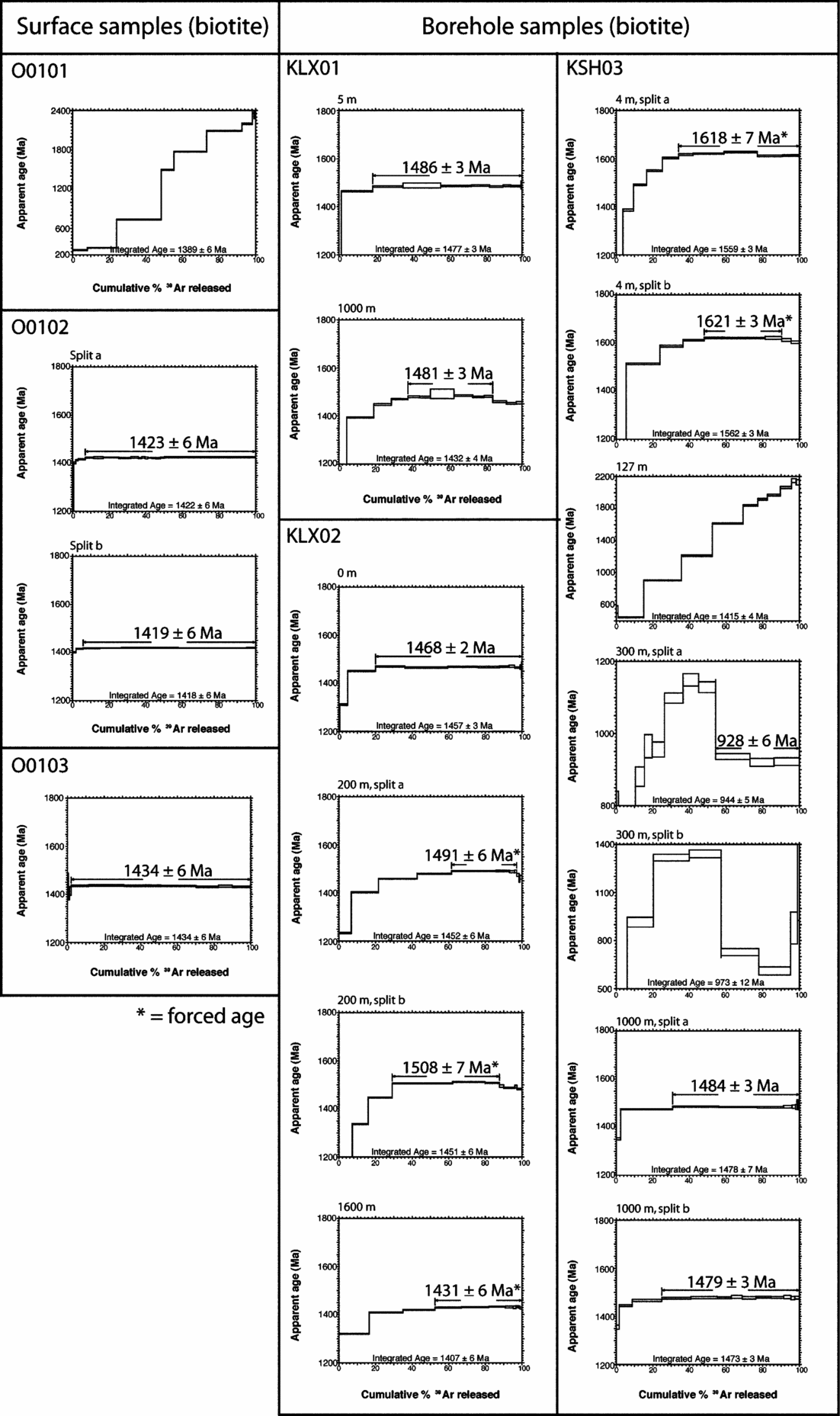
Figure 3 40Ar–39Ar step heating spectra for biotite samples.
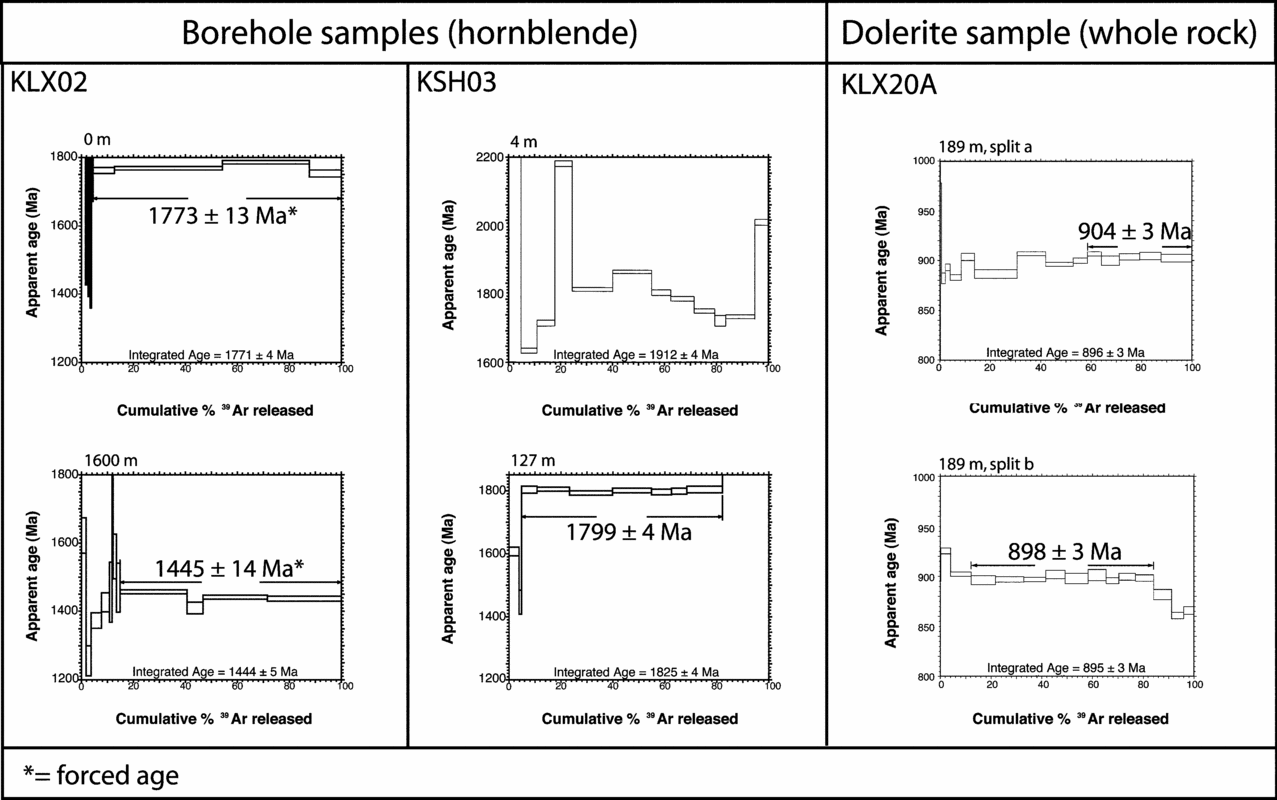
Figure 4 40Ar–39Ar step heating spectra for hornblende and whole-rock samples.
Table 1. 40Ar–39Ar ages and sample information
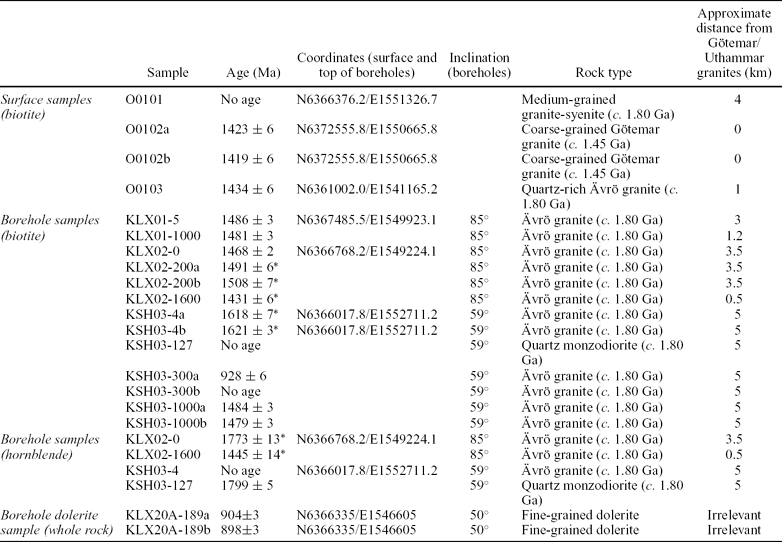
Samples are denoted in the format KLX01–5, where ‘KLX01’ refers to the sample name and ‘5’ refers to the borehole length where the sample was taken. Coordinates in RT 90, 2.5 gon V. * – Forced age; a-b refers to individual splits of the same sample.
Surface sample O0101 is located just outside the Oskarshamn power plant. It is a homogeneous, medium-grained rock with sparse K-feldspar phenochrysts. The sample yielded an uninterpretable staircase-like spectrum that is not considered further. Surface sample O0102 is a coarse-grained variety of the Götemar intrusion. From this sample, duplicate analyses of biotite (O0102a and O0102b) yielded, within error, identical ages of 1423±6 Ma and 1419±6 Ma, defined by c. 95% of total 39Ar release. Surface sample O0103 is a red, homogeneous, quartz-rich granite situated about 1 km west of the Uthammar intrusion. The analysis yielded a plateau age of 1434±6 Ma defined by almost 100% of the total 39Ar release.
KLX01 is a 1000 m long, subvertical borehole located a few kilometres south of the Götemar granite. It is dominated by Ävrö granite with subordinate mixing-mingling lithologies of fine-grained diorite to gabbro, fine-grained granite, diorite to gabbro, medium- to coarse-grained granite and certain sections of pegmatite. Samples were taken at subsurface level (at 5 m borehole length) and at 1000 m borehole length; both samples were made up of Ävrö granite. The near-surface sample, KLX01–5, yielded an age of 1486±3 Ma, representing about 80% of the total 39Ar release. At 1000 m borehole length, the sample KLX01–1000 yielded an age of 1481±3 Ma (defined by 50% of the total 39Ar release).
KLX02 is a 1700 m long, subvertical borehole located a few hundred metres southwest of KLX01. The dominant rock type is Ävrö granite in the 0–1450 m interval, except for the 540–960 m interval where the granite shows mingling with fine-grained diorite. Quartz monzodiorite dominates in the 1450–1700 m interval. Subordinate associated rock types comprise fine-grained diorite to gabbro and fine-grained granite. The borehole penetrates a brittle deformation zone between 770 and 960 m borehole length (Hultgren et al. Reference Hultgren, Stanfors, Wahlgren, Carlsten and Mattsson2004). Samples were taken from three levels, all represented by Ävrö granite. At the surface, sample KLX02–0 yielded an age of 1468±2 Ma, defined by 80% of the 39Ar release. At the 200 m borehole length, two splits of sample KLX02–200 (KLX02–200a and KLX02–200b) were analysed, yielding similar ages of 1491±6 Ma and 1508±7 Ma. However, both results represent forced plateau ages; KLX02–200a comprises three overlapping steps but only 35% of 39Ar release, whereas KLX02–200b is based on three non-overlapping steps represented by 55% of the 39Ar release. At 1600 m borehole length, sample KLX02–1600 yielded an age of 1431±6 Ma defined by 45% of the 39Ar release. In addition to biotite, hornblende from samples KLX02–0 and KLX02–1600 were also dated with 40Ar–39Ar geochronology. These samples yielded forced plateau ages of 1773±13 Ma and 1445±14 Ma, respectively. The ages were defined by about 80% of the released 39Ar gas, but with slightly inconsistent age steps.
The third borehole, KSH03, was drilled with an inclination of about 60° and comprises two cores; KSH03B represents the first 100 m of borehole length of the bedrock and KSH03A the following 900 m. For simplicity, the two boreholes are treated as one and referred to as KSH03. The borehole penetrates a major NE-trending deformation zone (ZSMNE024A: Wahlgren et al. Reference Wahlgren, Hermanson, Forssberg, Curtis, Triumf, Drake and Tullborg2006b), which is modelled with a northwesterly dip (Fig. 2, left and lower right). The bottom of the borehole reaches a depth of about 870 m. The dominant rock type is Ävrö granite, but some sections are made up of quartz monzodiorite and fine-grained granite. Subordinate rock types include diorite to gabbro and medium-grained granite. Biotite samples were taken from four different levels (4, 127, 300 and 1000 m), where the distances refer to the length of the borehole, thus uncorrected for the inclination. All samples consist of Ävrö granite except KSH03–127, which is from a quartz monzodiorite. Duplicate analyses from sample KSH03–4 (KSH03–4a and KSH03–4b) yielded identical ages, within error, of 1621±3 Ma (45% of total 39Ar release) and 1618±7 Ma (forced plateau of five non-overlapping steps comprising 70% of total 39Ar release), respectively. At 127 m, sample KSH03–127 yielded a staircase-like spectrum with no interpretable result. The two splits of sample KSH03–300 at 300 m (KSH03–300a and KSH03–300b) yielded ages that are difficult to interpret. KSH03–300a yielded an age of 928±6 Ma. The plateau is defined by 45% of total 39Ar release with previous steps giving older ages (around 1150 Ma). KSH03–300b did not yield an interpretable age. At 1000 m, sample KSH03–1000 was analysed twice (KSH03–1000a and KSH03–1000b) and yielded two identical plateau ages, within error, of 1484±3 Ma and 1479±3 Ma. Both plateaus were defined by ≥70% of total 39Ar release.
Two hornblende samples, one from KSH03–4 and one from KSH03–127, were also analysed. Sample KSH03–4 did not yield an interpretable age, whereas sample KSH03–127 yielded a well-defined plateau age of 1799±4 Ma, representing 75% of the released 39Ar gas.
Borehole KLX20A was drilled with an inclination of 50° to the west. The sample of fine-grained dolerite was collected from near the 189 m level, borehole length. Two splits were analysed, yielding ages of 904±3 Ma and 898±3 Ma, representing 40% and 70%, respectively, of the 39Ar gas released.
3.c. Interpretation of the dolerite whole-rock age and ages bordering a fracture zone through KSH03
Published U–Pb baddeleyite dates from the Blekinge-Dalarna Dolerites in SE Sweden fall in the range 970–946 Ma (Söderlund et al. Reference Söderlund, Isachsen, Bylund, Heaman, Patchett, Vervoort and Andersson2005). A slightly younger result (c. 935 Ma) from a dolerite near Gothenburg in the Idefjorden terrain was reported by Hellström, Johansson & Larson (Reference Hellström, Johansson and Larson2004). The age for the dolerite in borehole KLX20A is thus several tens of millions of years younger than earlier reported for the Blekinge-Dalarna Dolerites in southern Sweden.
KSH03 intersects a ductile deformation zone/fault zone between borehole length 162 and 275 m (ZSMNE024A; Fig. 2, lower right). The zone has been subjected to polyphase brittle reactivation (Hultgren et al. Reference Hultgren, Stanfors, Wahlgren, Carlsten and Mattsson2004), which possibly explains scatter in the 40Ar–39Ar biotite spectra of samples at the border of the zone (127 m and 300 m; Fig. 3). The poorly defined biotite age of 928±6 Ma at the 300 m level (Fig. 3) indicates late Sveconorwegian disturbance that may relate to the emplacement of dolerite intrusions. The second analysis of the same sample (KSH03–300b) did not yield an interpretable age. Drake, Page & Tullborg (Reference Drake, Page and Tullborg2007) have dated adularia from two fracture zones in KSH03A, yielding ages of 989±2 Ma and 401±1 Ma. We realize that our age spectra from the 127 and 300 m borehole length in KSH03 are inconclusive and they will not be discussed further.
4. Discussion
The 40Ar–39Ar biotite and hornblende ages from Oskarshamn fall into three groups: ≥1.62 Ga, 1.51–1.47 Ga and 1.43–1.42 Ga (Table 1). The ages obtained from the boreholes KLX01, KLX02 and KSH03 are shown in vertical cross-sections in Figure 2, upper and lower right panels.
4.a. Cooling following crystallization of c. 1800 Ma, and younger, Transscandinavian Igneous Belt rocks
The hornblende ages of 1799±5 Ma and 1773±13 Ma (Fig. 2, upper and lower right; Fig. 4) are suggested to date cooling through 500°C after emplacement of 1.80 Ga plutons. The 1799±5 Ma age indicates fast cooling in a magmatically highly active area. The age spectrum does not show any indications of excess Ar. The 1773±13 Ma ages derived from a forced plateau where the spectrum indicates minor Ar loss, and therefore the age is interpreted as a minimum age for cooling through the 500°C isotherm. The rapid cooling, as indicated by these results, favours shallow emplacement of the intrusion, in agreement with preservation of coeval supracrustal rocks in scattered areas in the Småland–Värmland Belt (Wikman & Kornfält, Reference Wikman and Kornfält1995; Söderlund & Rodhe, Reference Söderlund and Rodhe1998; Wahlgren et al. Reference Wahlgren, Ahl, Sandahl, Berglund, Petersson, Ekström and Persson2004).
The c. 1620 Ma biotite ages of borehole KSH03 are based on duplicates yielding indistinguishable results. The spectra show signs typical for loss of Ar and the ages are thus interpreted as minimum ages. The biotite grains in the sample are fresh with no signs of alteration (e.g. chloritization). If our interpretation of the hornblende ages are correct, that is, that they indicate shallow emplacement and initial fast cooling to 500°C, the subsequent cooling to 300°C must have been extremely slow (on average 1.1°C Ma−1) on the assumption that the c. 1620 Ma biotite ages represent continuous cooling from the event of magma crystallization. An alternative interpretation, and the one preferred here, is that the c. 1620 Ma biotite ages reflect regional heating followed by cooling associated with the youngest period (1.68–1.67 Ga) of Transscandinavian Igneous Belt magmatism in south-central Sweden.
4.b. Interpretation of younger ages
The younger ages fall into two separate age groups: c. 1.51–1.47 Ga and c. 1.43–1.42 Ga, which provide evidence for two distinct thermal events. The age groups coincide with regionally tectonothermal events: the 1.65–1.47 Ga rapakivi intrusions (cf. Alviola et al. Reference Alviola, Johanson, Rämö and Vaasjoki1999; Dörr et al. Reference Dörr, Zdzislaw, Marheine, Schastok, Valverde-Vaquero and Wiszniewska2002 and references therein) and magmatism of the 1.47–1.44 Ga Danopolonian event (Bogdanova et al. Reference Bogdanova, Bingen, Gorbatschev, Kheraskova, Kozlov, Puchkov and Volozh2008; Brander & Söderlund, Reference Brander and Söderlund2008).
The older group 40Ar–39Ar ages range between 1508±7 and 1468±2 Ma. The perhaps most straightforward interpretation is that these ages represent incomplete resetting during thermal heating from the 1.45–1.44 Ga Götemar and Uthammar intrusions. The relatively narrow age interval of this group is, however, defined by as many as seven analyses, and incomplete resetting would be expected to result in a more scattered age range. Further, similar 40Ar–39Ar hornblende ages (c. 1.57–1.47 Ga: Page et al. Reference Page, Beunk, Bogdanova and Wijbrans1999; Beunk & Page, Reference Beunk and Page2001) occur in the area close to the Loftahammar–Linköping Deformation Zone (Fig. 1), which indicates a similar thermal history further to the north. One statistically significant 40Ar–39Ar biotite age from a surface sample close to Norrköping (Fig. 1) gave 1494± 3 Ma (Page et al. Reference Page, Hermansson, Söderlund and Stephens2007). The latter results cannot be explained by partial resetting of younger c. 1.45 Ga intrusions, as there are no intrusions of such age present in these areas.
The episodic and prolonged activity of rapakivi magmatism has been suggested to originate from extensive thermal activity in the lower crust (e.g. Puura & Flodén, Reference Puura and Flodén1999), possibly as the result of distal active margin processes in the west (Åhäll, Connelly & Brewer, Reference Åhäll, Connelly and Brewer2000). Although no rapakivi intrusions have been observed in the Oskarshamn area, we cannot dismiss regional heating associated with rapakivi magmatism that caused resetting of the 40Ar–39Ar system in biotite at 1.51–1.47 Ga. Another possibility is early thermal activity related to the onset of the Danopolonian event. Presently, data are too sparse to make any final interpretation of this group of 40Ar–39Ar ages.
The youngest age group (1.43–1.42 Ga biotite ages) reflects local thermal effects associated with emplacement of the Götemar and Uthammar intrusions at 1.45–1.44 Ga. Geophysical modelling indicates that the southern contact of the Götemar granite dips to the south. The positions of the boreholes with respect to the intrusions are illustrated in Figure 2, upper right. Sample O0102 is from the 1452+11/-9 Ma Götemar granite (Åhäll, Reference Åhäll2001) (Fig. 2, left) and dates cooling through 300°C of the granite at c. 1.42 Ga. Sample O0103 is from the 1.80 Ga Ävrö granite less than one kilometre from the Uthammar granite (Fig. 2, left). The intrusion at 1441+5/-3 Ma of the Uthammar granite (Åhäll, Reference Åhäll2001) thermally affected the surrounding bedrock, which was subsequently cooled below 300°C at 1434±6 Ma. At the bottom of KLX02, the hornblende and biotite ages demonstrate that this locality, consisting of 1.80 Ga Ävrö granite, was thermally affected by the Götemar intrusion and cooled below 500°C at 1445±14 Ma, and subsequently cooled below 300°C at 1431±6 Ma (Fig. 2, upper right). The age difference between the biotites taken in the surrounding bedrock (c. 1.43 Ga) and that within the pluton (c. 1.42 Ga) reflects the more rapid cooling of the thermal aureole at a distance from the intrusion.
5. Conclusions
The 1799±5 Ma and 1773±13 Ma hornblende ages suggest that the 1.80 Ga granites belonging to the Transscandinavian Igneous Belt in the Oskarshamn area crystallized at a shallow level and initially cooled rapidly. The c. 1620 Ma biotite ages are suggested to reflect regional cooling after the youngest (1.68–1.67 Ga) magmatism in the Transscandinavian Igneous Belt in south-central Sweden.
The 1.51–1.47 Ga biotite ages are enigmatic to interpret. They may represent partial resetting by the c. 1.45–1.44 Ga Götemar and Uthammar plutons, or reflect regional heating by rapakivi magmatism. A third possibility is that the ages are associated with thermal activity at the onset of the Danopolonian event. Further investigations are needed for better understanding of this group of ages. The 1.43–1.42 Ga biotite ages date cooling of the Götemar and Uthammar granite intrusions and the thermally affected bedrock in the immediately adjacent area.
Whole rock samples from a 15–20 m wide dolerite dyke yielded ages of c. 900 Ma, possibly indicating that the 978–946 Ma Blekinge-Dalarna Dolerites extend toward younger ages. These dolerite intrusions are believed to have affected the bedrock locally in the Oskarshamn area as indicated by a poorly defined biotite age of 928±6 Ma and other disturbed ages of samples bordering a complex deformation zone.
Acknowledgements
We thank the Swedish Nuclear Fuel and Waste Management Company (SKB) for funding the analyses. We also thank Leif Stenberg, Tomas Kiesel, Fredrik Hartz and others at SKB for helping with providing samples and figures for the article. We would also like to thank Svetlana Bogdanova, Tobias Hermansson, Charlotte Möller and Carl-Henric Wahlgren for reading and commenting on early versions of the manuscript. All SKB reports in the reference list can be downloaded from the SKB homepage (www.skb.se). Editorial reviews by Joakim Mansfeld and an anonymous referee are greatly appreciated, and we thank David Pyle and Jane Holland for professional editorial handling. Tabulated age data for studied sites is available from authors on request, or online at http://www.earthchem.org/earthchemWeb/index.jsp.


